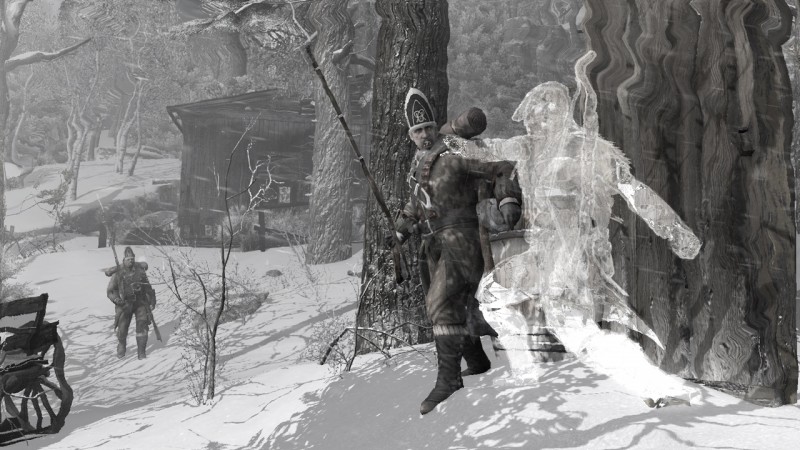Assassin’s Creed III: The Infamy DLC Impressions

Leading up to its launch, I’ve been keen to learn how Ubisoft planned to integrate the alternate history storyline of its new DLC into the main game. The answer turns out to be more surprising and entertaining than I might have thought. The Tyranny of King Washington has its own menu entry when you start up Assassin’s Creed III, so it won’t tie into your main campaign at all.
Launch this new, second single-player campaign, and you’re treated to a confusing jumble of initial images that indicate Washington’s corruption by an artifact of the First Civilization. Connor awakes from a dream, and you’re off to the races. The big difference is that you’re not Connor – in this world, Ratonhnhaké:ton never left his tribal heritage to meet Achilles, so he kept his original name. The catch is that Ratonhnhaké:ton remembers his life as Connor, and from the start of this new DLC, he is wandering through the world with the recognition that something has gone horribly wrong.

The Infamy is the first episode of three that explore this odd new side trek in the Assassin’s Creed fiction. The first installment is about as long as one lengthy memory sequence of the core game. Along with new side content, that’s going to have you running around the frontier for a couple of hours, complete with new voiceover, cut scenes, and missions. If you really dig into every collectible and side quest, you might double that time.
Ratonhnhaké:ton’s missions in this timeline revolve around combating the villainy of King Washington. The insidious founding father is enslaving the Native American population, setting torch to Lexington, and setting his “bluecoats” to all sorts of treachery and murder. A few of these missions play to Assassin’s Creed III’s strengths, with a focus on traversal, bringing down assassination targets, and engaging in mystical drug-induced spirit journeys. Other missions are weaker, including an investigation mission that has you wandering a large wilderness space trying to spot clues, and another lackluster cannon sequence.
The Infamy’s biggest step away from the core game’s experience is the addition of animal powers. After communing with wolves through the power of a mysterious tea, Ratonhnhaké:ton begins to unlock powers that stretch the boundaries of credulity, even within the Assassin’s Creed fiction. Had this been a core Assassin’s Creed story, I’d balk at the divergence into mystical and magical wolf powers. As it is, the new mechanics are a fun addition to the toolbelt. One power lets you summon a cadre of spectral wolf attackers, who tear your enemies to pieces – in practice, it’s an ability that replicates calling your brotherhood to attack. The second and more interesting power gives the power to turn invisible as you stalk your foes, but at the cost of a rapid health drain. This new power makes stealth sequences far more enjoyable than in the base game, even as it veers the most out of the traditions of the franchise. Other new powers are supposedly on the way in future installments, which will further enhance our hero’s animalistic tendencies.

Most of The Infamy plays out in the winter version of the Frontier map from the main game, but many locales and buildings have been changed to reflect the altered history; a bustling tavern from the main game appears as a burnt husk in the DLC. In addition, the frontier has been stocked with a new set of citizen-focused objectives and treasure chests. While these side events don’t offer significant gameplay opportunities, they do contribute added atmosphere. Feeding starving people gathered around a fire, or freeing a caravan of slaves helps sell the dark tone of the new setting.
The Infamy is hard to recommend on its own until we have a larger picture of how the second and third episodes will pan out. The first episode ends on a cliffhanger, and the gameplay presented in The Infamy isn’t as strong as the base game. In addition, I witnessed some significant technical hiccups, including some distracting jagged shadows. Nonetheless, I applaud the intriguing story approach, which has given developers leeway to plot a whole new direction for their latest hero, and play around with game mechanics that would feel heretical in the core story.
The full arc of The Tyranny of King Washington remains to be seen, and in sum may emerge as a worthwhile experience. Until then, The Infamy is likely a must buy only for the most faithful of Assassin’s Creed fiction fans.

Get the Game Informer Print Edition!
Explore your favorite games in premium print format, delivered to your door.
- 10 issues per year
- Only $4.80 per issue
- Full digital magazine archive access
- Since 1991









